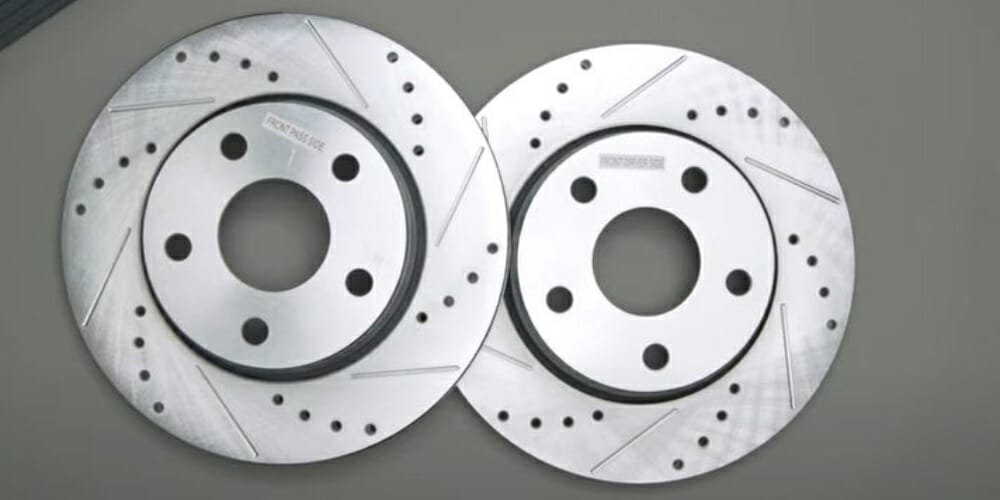Do Drilled And Slotted Rotors Last Longer

The debate surrounding drilled and slotted brake rotors rages on in garages and online forums alike. Do they offer superior performance? Absolutely, in specific scenarios. But the million-dollar question – and the one we're tackling today – is whether those performance enhancements come at the cost of longevity. Do drilled and slotted rotors actually last longer than their plain, solid counterparts? The answer, as with many things automotive, is a resounding "it depends."
Understanding the Design
To understand the potential lifespan implications, we need to delve into the design differences. Drilled rotors feature holes bored through the rotor face, while slotted rotors have grooves machined into the surface. Both modifications are primarily aimed at improving braking performance in demanding situations.
The purported benefits of drilling and slotting include:
- Improved Heat Dissipation: Holes and slots increase surface area, theoretically allowing heat to escape more quickly.
- Enhanced Gas Venting: In older brake pad compounds, outgassing (the release of gases from the pad material under extreme heat) could create a layer between the pad and rotor, reducing friction. Drilled and slotted rotors were designed to vent these gases. While modern pad technology has largely mitigated this issue, some benefit may still exist in extreme conditions.
- Water Dispersion: Slots can help channel water away from the braking surface in wet conditions, improving initial bite.
- Improved Initial Bite: Some argue that the edges of the holes and slots provide more "bite" on the brake pad, resulting in faster braking response.
The Wear Factor: A Double-Edged Sword
While these benefits can enhance braking performance, they also introduce factors that can shorten rotor lifespan. The primary culprit is reduced structural integrity. Removing material from the rotor face, whether through drilling or slotting, inherently weakens the overall structure.
Drilled rotors, in particular, are susceptible to cracking around the drilled holes. This is especially true in high-performance applications where rotors experience extreme thermal stress. The holes act as stress concentrators, making them prime locations for crack initiation and propagation. Over time, these cracks can grow and compromise the rotor's integrity, necessitating replacement.
Slotted rotors, while generally less prone to cracking than drilled rotors, still suffer from material removal. The slots reduce the rotor's mass and therefore its ability to absorb and dissipate heat. This can lead to increased rotor temperatures and accelerated wear. Furthermore, aggressive slot designs can also contribute to accelerated brake pad wear. The sharp edges of the slots can act like small rasps, gradually shaving away at the brake pad material.
Material Matters: The Metallurgy Equation
The type of metal used in rotor construction also plays a significant role in lifespan. High-quality rotors, made from premium alloys with specific heat treatment processes, are generally more resistant to cracking and wear than cheaper alternatives. If you choose to run drilled or slotted rotors, opt for reputable brands that use high-quality materials and manufacturing processes.
The pad material also affects rotor wear. Abrasive brake pads will accelerate rotor wear regardless of whether they are drilled, slotted, or plain. Choosing a pad compound appropriate for your driving style and vehicle type is crucial for maximizing rotor lifespan.
Driving Style and Environment
Aggressive driving habits, characterized by frequent hard braking, will inevitably shorten rotor lifespan, especially with drilled and slotted rotors. Track days and spirited driving on winding roads put immense stress on the braking system, accelerating wear and increasing the risk of cracking. Similarly, driving in environments with frequent stop-and-go traffic or exposure to harsh road conditions (salt, sand) will also contribute to accelerated wear.
The Verdict
In most everyday driving situations, drilled and slotted rotors are unlikely to last longer than plain rotors. In fact, they may even wear out faster due to the reduced structural integrity and increased stress concentration. However, in specific high-performance applications or when paired with appropriate brake pads and careful driving habits, the performance benefits may outweigh the potential reduction in lifespan. Ultimately, the decision to use drilled or slotted rotors should be based on a careful consideration of your driving needs, vehicle type, and budget.
It's crucial to remember that proper maintenance, including regular brake inspections and timely replacements, is essential for ensuring safe and reliable braking performance, regardless of the type of rotor you choose.
